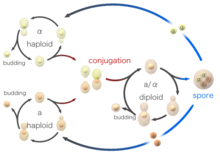Budding
| Parent |
| Cell division |
| Gene Ontology |
|---|
| QuickGO |
The budding or budding (also gemmation ) is a type of vegetative propagation , a sub-form of asexual reproduction . It can occur in protozoa as well as multicellular organisms including fungi , animals and plants .
- In bacteria , budding refers to uneven cell division that takes place through local growth. The daughter cell ( bud ) is usually smaller than the mother cell, in contrast to the split . Budding bacteria include some aquatic and soil bacteria.
- In single-celled yeasts and multicellular fungi , one of the two protoplasts previously formed by cell division emerges from a porus of the common cell wall and forms a new cell wall, while the other protoplast remains in the old cell wall and only needs to close the porus. The pores can be recognized by the so-called scars on the parents . In some filamentous fungi which are conidia in stand fungi ( Basidiomycetes ) the basidiospores by budding formed.
- In plants, local growth processes lead to outgrowths that more or less completely separate from the mother plant.
- Multicellular animals pinch off cell complexes on the surface of the mother individual, creating daughter individuals; if these remain on the mother organism, colonies develop. Buds can be found in sponges (Porifera), cnidarians (Cnidaria), bryozoa (bryozoa), tunicates (Tunicata) and some annelids ( Naidinae ).
- Join enveloped viruses from the host cell, they use part of the host cell membrane as the viral envelope and is known as "budding" or budding .
